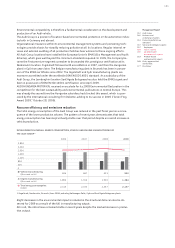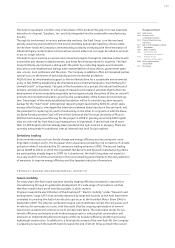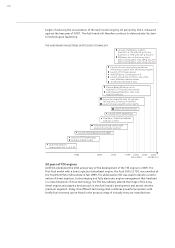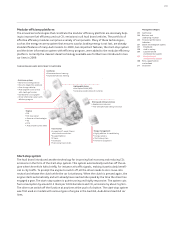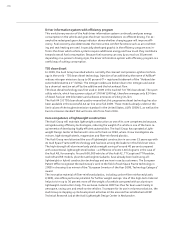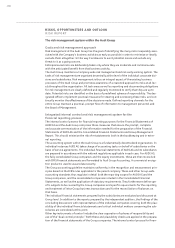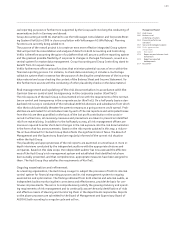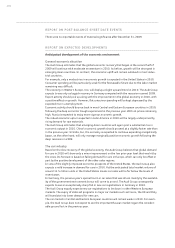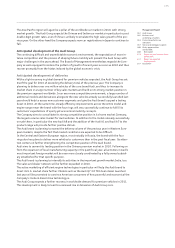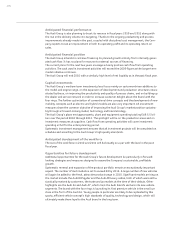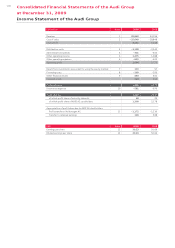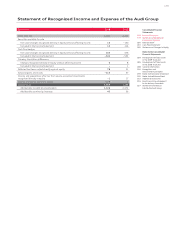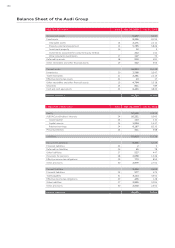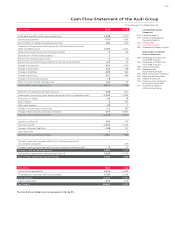Audi 2009 Annual Report Download - page 174
Download and view the complete annual report
Please find page 174 of the 2009 Audi annual report below. You can navigate through the pages in the report by either clicking on the pages listed below, or by using the keyword search tool below to find specific information within the annual report.
171
Management Report
132 Audi Group
140 Business and
underlying situation
153 Financial performance
indicators
157 Social and ecological aspects
168 Risks, opportunities
and outlook
168 Risk report
174 Report on post-balance sheet
date events
174 Report on expected
developments
177 Disclaimer
Industry risks
Along with the economic recovery, the situation on financial markets has significantly bright-
ened. Restrictive lending practices by banks and elevated risk surcharges for borrowed capital
nevertheless continue to present a major challenge to large sections of the automotive industry.
Thanks to the Audi Group’s successful business performance in recent years, it has high liquidity
at its disposal and therefore considers itself to be well equipped to tackle the challenges of the
future.
One consequence of tighter lending practices is that a noticeable reluctance has been detected
among customers to make purchases. Moreover, bad debts and the remeasurement of residual
value risks are undermining the financial performance, net worth and financial position of many
enterprises. Thanks to the Audi Group’s cautious use of vehicle financing instruments within its
profit-oriented growth strategy, it is exposed to only modest economic risk here. Its long-
established conservative approach to the assessment of residual values when concluding vehicle
financing is effective in mitigating risks. In the absence of a dramatic deterioration in the situa-
tion on the used-car market, the Audi Group assumes that the risks from sales of used cars are
adequately covered.
The massive slump in demand in certain areas of the international car market prompted by the
economic crisis has noticeably aggravated predatory competition practices. As a consequence,
the increased use of sales incentives has been observed. This development may result in price
erosion and higher marketing costs particularly in the Audi Group’s key sales regions of Western
Europe, the United States and China, which would in turn adversely affect the Company’s rev-
enue and earnings performance. The pricing practices of the Company’s direct competitors could
have an equally negative effect on its revenue and profits, as it would be unable to resist such a
trend in the long term. Moreover, potential state subsidies for individual manufacturers or vehi-
cle categories could distort competition, thereby adversely affecting the financial position of the
Audi Group.
Growing pressure to reduce the fuel consumption and emissions of vehicles remains a huge
challenge for the entire automotive industry. In addition to the various legal requirements being
discussed around the world, such as CO2 limits, a protracted public debate could adversely affect
the image of all manufacturers and so ultimately be to the detriment of the Audi Group’s finan-
cial performance. In addition, the heightened sensitivity of customers to environmental accept-
ability and fuel economy means a permanent shift in the demand profile in individual markets
towards smaller, lower-consumption vehicles cannot be excluded. As in the past, the Audi Group
is prepared to actively tackle this challenge through “Vorsprung durch Technik.” It has employed
a wide range of technological innovations in the fields of lightweight construction, aerodynam-
ics and energy efficiency to improve the efficiency and CO2 emissions of the entire vehicle fleet
quite substantially over the past few years. The Company is also intensively researching alterna-
tive fuels and drive concepts such as electric mobility and offering its customers mobility con-
cepts tailored to varying requirements.
Risks from operating activities
There are a number of risks associated with the Audi Group’s operating activities that could
lastingly affect its net worth, financial position and financial performance.
These include unforeseeable occurrences such as explosions or major fires that could damage or
destroy the Group’s assets and also cause considerable consequential losses by hindering the
production process. Major production problems could also be caused by disruptions to the en-
ergy supply or technical disruptions, in particular to information technology. Although such risks
harbor considerable potential for losses, their probability is viewed as being relatively low. The
Audi Group counteracts these risks in particular through adequate insurance coverage and pre-
ventive measures, such as fire protection systems. The high flexibility of the Audi production
network also reduces the risk.


